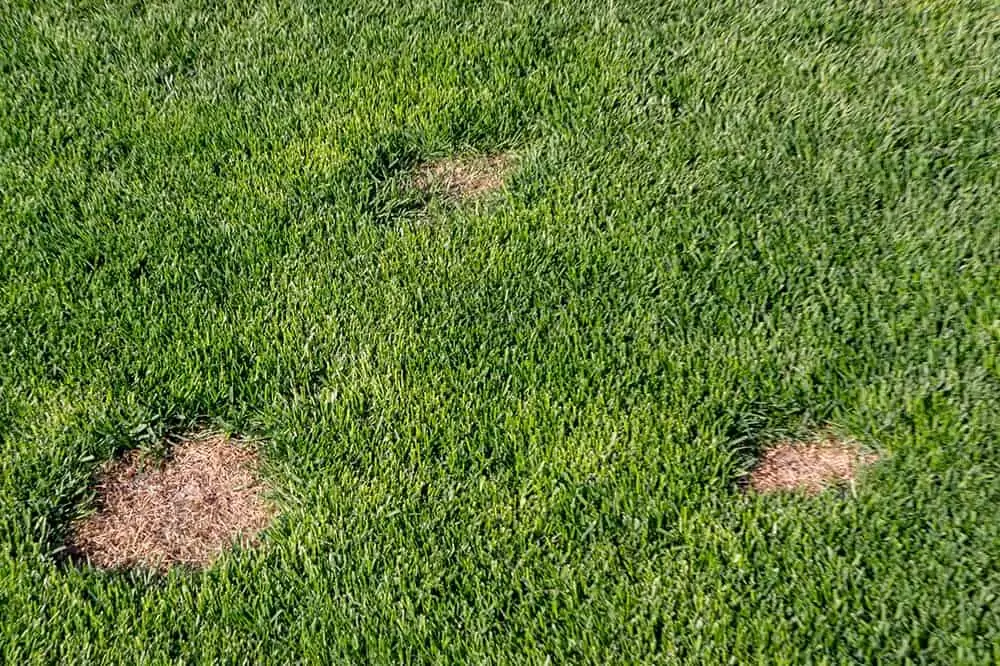“I gazed out the window at my once-verdant lawn, now a patchwork of brown and green. Desperation gnawed at me, knowing I had to restore its former glory.”

Image: lawndiseases.com
Assessing the Culprit: Causes of Dead Lawn Patches
What transforms a lush lawn into lifeless patches? The causes can be as varied as the grass species itself.
- Lack of Water: Drought conditions parch the shallow roots of grass, leading to dehydration and dormancy.
- Soil Compaction: Heavy foot traffic or improper mowing techniques compact the soil, obstructing water and nutrient absorption.
- Disease: Fungal infections, such as brown patch or dollar spot, thrive in certain soil conditions, attacking and discoloring grass blades.
- Insects: Grubs and armyworms feast on grass roots, causing rapid decline and unsightly bare spots.
- Nutrient Deficiency: Insufficient nitrogen, phosphorus, or potassium prevents grass from photosynthesizing effectively.
A Step-by-Step Revival Plan for Dead Lawn Patches
Reviving dead lawn patches requires a holistic approach that addresses the underlying culprit and promotes healthy lawn growth.
1. Assess Your Lawn: Determine the cause of the dead patches by considering factors such as weather conditions, soil moisture, and pest infestation.
2. Address Water Needs: Water your lawn deeply and infrequently, allowing the water to fully reach the roots. In drought conditions, increase watering frequency to maintain soil moisture.
3. Aerate the Soil: Use a lawn aerator to create holes in the soil, improving drainage and oxygen flow to grass roots.
4. Control Diseases: Apply fungicides specifically formulated for lawn diseases. Follow application instructions carefully and repeat as needed to eradicate the infection.
5. Eliminate Insects: Treat lawn for insects with effective insecticides. Apply according to the product label to target specific pests without harming beneficial insects.
6. Fertilize Properly: Perform a soil test to determine soil nutrient levels and adjust fertilization accordingly. Fertilize during active growing seasons to support strong grass growth.
7. Overseed Bald Spots: Once the dead patches have been treated, overseed with a compatible grass seed mixture. Water and fertilize regularly to promote healthy germination and growth.
8. Promote Microbial Activity: Consider using natural soil amendments, such as compost or humic acid, to enhance soil biodiversity and improve grass resilience.
9. Establish Healthy Mowing Practices: Mow grass at an appropriate height with a sharp mower blade. Leave clippings on the lawn to add organic matter and nutrients to the soil.
Additional Tips for Lawn Patch Recovery
- Avoid overseeding in areas with persistent shade or poor drainage.
- Clean and sharpen mower blades regularly to prevent tearing grass and promoting disease.
- Keep pets and excessive foot traffic off the affected areas.
- Consult with a lawn care professional for expert advice and specialized treatment options if necessary.
![[Dead Patches In Lawn] [Lawn Dead Patches] [Lawn Grubs] [Lawn Grub ...](https://i.ytimg.com/vi/XF6yFwnugtA/maxresdefault.jpg)
Image: www.youtube.com
FAQ: Demystifying Dead Lawn Patches
Q: How long will it take to revive dead lawn patches?
A: Recovery time varies depending on the cause of the problem and the extent of damage. With proper care, most dead patches can be restored within a few weeks to several months.
Q: Is it possible to prevent dead lawn patches?
A: By practicing good lawn care, such as regular watering, fertilization, and disease control, you can significantly reduce the risk of developing dead lawn patches in the future.
Q: Do I need to replace the entire lawn if I have multiple dead patches?
A: Not necessarily. Focused treatment and re-seeding can restore individual dead patches. However, if the problem is widespread and indications of severe disease or insect infestation are present, lawn replacement may be the best option.
Dead Patches On Lawn How To Fix
Conclusion
Dead lawn patches can be disheartening but are far from irreparable. By addressing the underlying causes, following the outlined revival plan, and implementing preventative measures, you can transform lifeless brown spots into areas of verdant green. Remember, a healthy lawn is a source of pride and tranquility, inviting you to relax and appreciate the beauty of nature.
“Now, as I survey my rejuvenated lawn, a sense of satisfaction washes over me. The once-blemished patches have vanished, replaced by a vibrant carpet of lush green. It’s a testament to the transformational power of persistence and proper lawn care.”







